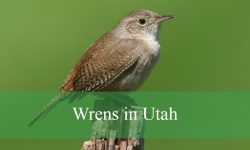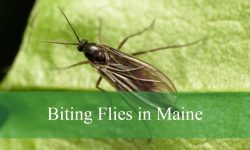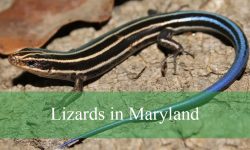Are you curious about animals that start with U? While the letter U might not be the most common initial letter for animal names, there are still plenty of fascinating creatures to discover. From unusual mammals and vibrant birds to intriguing reptiles and underwater species, this list showcases the diversity found among animals that start with U.
In this article, we’ll explore 48 animals that start with U, providing clear pictures and names to help you identify each one. If you’re a student, a wildlife enthusiast, or simply curious, this collection offers an engaging and informative look at some of the world’s most unique and lesser-known species starting with the letter U.
By the end of this guide, you’ll have learned about the habitats, behaviors, and special characteristics that make these animals stand out. So, dive in and get ready to expand your knowledge with this exciting lineup of animals that start with U!
Mammals That Start With U
Uakari (Cacajao spp.)

The Uakari is a small New World monkey easily recognized by its bright red, bald face and short tail. Covered in shaggy fur that can range from white to reddish-brown, the Uakari has a somewhat comical appearance, but its intense coloration serves an important purpose. A healthy, deep red face is a sign of good immune health, making it an important visual cue for mating.
These monkeys live in the flooded rainforests and riverbanks of the Amazon Basin, especially in parts of Brazil, Peru, and Colombia. They spend most of their time in the trees, traveling in groups and foraging for fruits, seeds, and small invertebrates. Their strong jaws allow them to crack open hard nuts that other species might avoid.
A fascinating fact about Uakaris is that they are highly sensitive to habitat disturbance and are considered vulnerable or endangered in some regions. Their short tails, unusual for monkeys, make them less agile but well-suited to moving among thick, lower canopies where they leap rather than swing.
Ugandan Kob (Kobus kob thomasi)
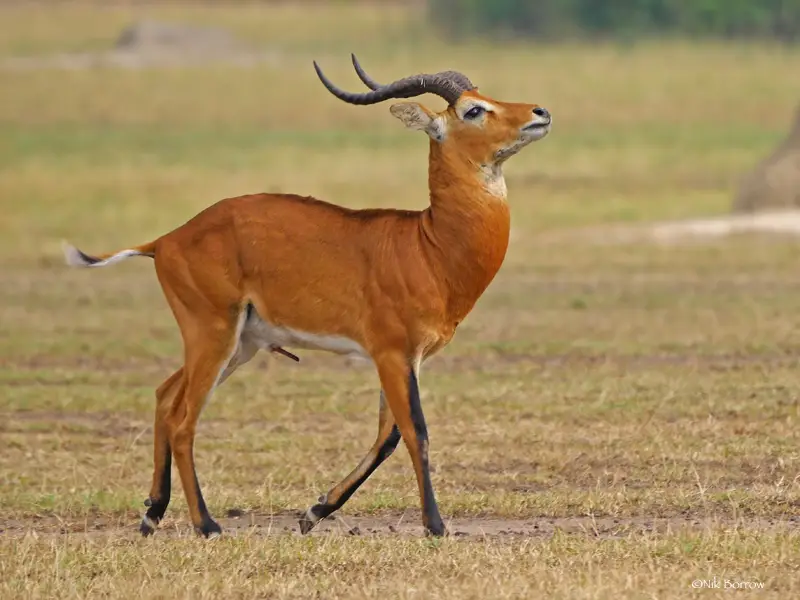
The Ugandan Kob is a graceful antelope with a reddish-brown coat and white underparts. Males are easily identified by their striking lyre-shaped horns and slightly darker coloration. Females lack horns and form large herds, while males establish and defend territories during the breeding season.
This species is primarily found in savannas, floodplains, and grasslands near water sources in Uganda and neighboring countries like South Sudan and the Democratic Republic of the Congo. They are often seen grazing in open areas, where they can keep a watchful eye out for predators such as lions and hyenas.
One fun fact about the Ugandan Kob is that it once appeared on the coat of arms of Uganda, symbolizing the country’s rich wildlife. It plays an important role in the ecosystem by shaping vegetation through grazing and serving as prey for large carnivores.
Uinta Chipmunk (Neotamias umbrinus)
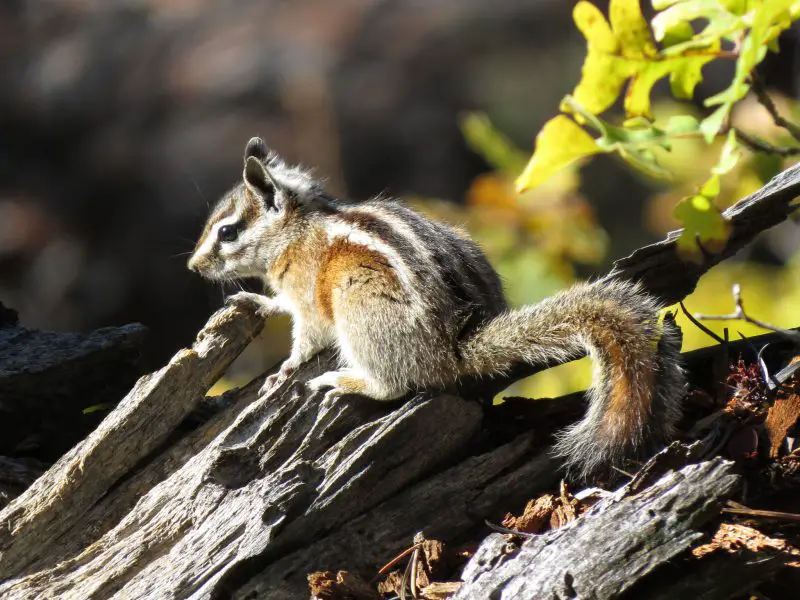
The Uinta Chipmunk is a small, striped rodent native to the western United States, particularly around the Uinta Mountains and the central Rocky Mountains. It features distinctive dark and light stripes running down its back and face, with a bushy tail and alert, expressive eyes.
This species inhabits coniferous forests, rocky outcrops, and high-altitude meadows, often at elevations between 6,000 and 10,000 feet. Uinta Chipmunks are solitary and territorial, frequently seen darting through underbrush and climbing trees in search of seeds, berries, and insects.
Unlike ground squirrels, Uinta Chipmunks do not hibernate in the traditional sense. Instead, they cache food in their burrows and periodically wake throughout the winter to feed. Their hoarding behavior is critical to their survival in the harsh mountain climates they call home.
Uinta Ground Squirrel (Urocitellus armatus)
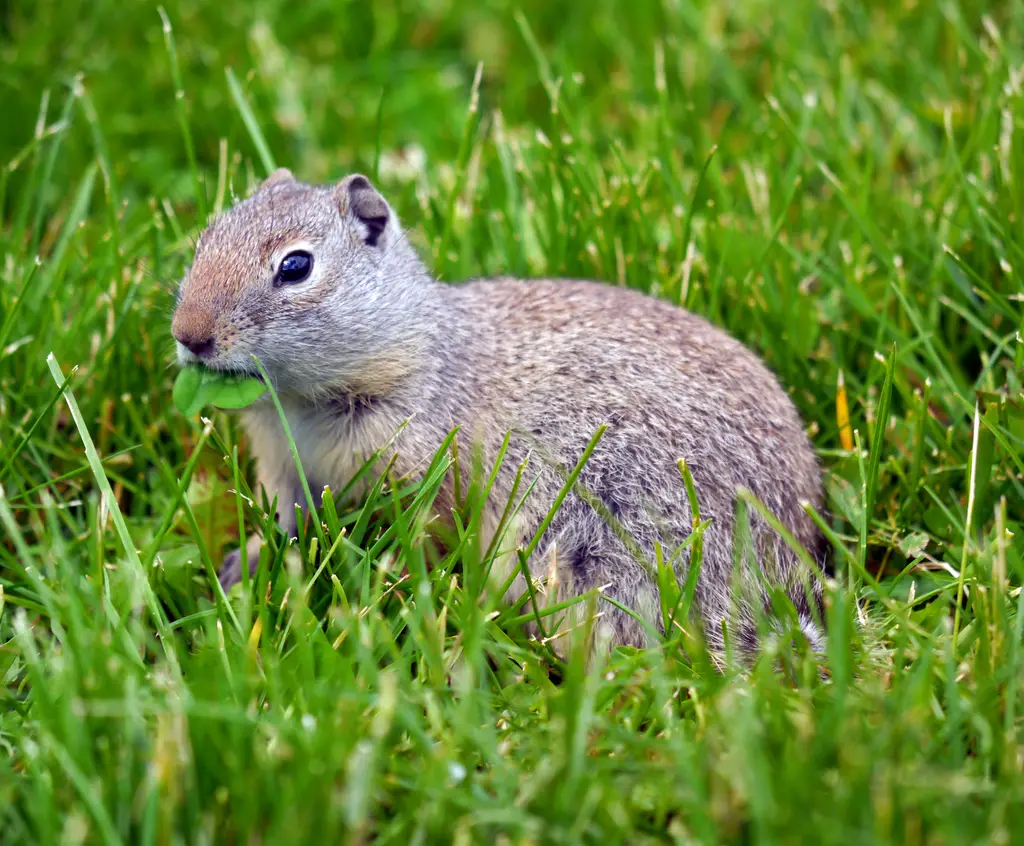
The Uinta Ground Squirrel is a burrowing rodent known for its chubby body, short tail, and light brown to grayish fur. It is often mistaken for a prairie dog or a large chipmunk but lacks the facial striping and has a more uniform color.
This species is found mainly in grasslands, sagebrush areas, and mountain meadows of Utah, southern Idaho, and western Wyoming. It prefers open areas where it can keep watch for aerial and ground predators, and it spends much of its life in underground burrows.
An interesting fact about the Uinta Ground Squirrel is that it has one of the shortest active seasons of any North American mammal—just 3 to 4 months. The rest of the year, it remains in hibernation, surviving off fat reserves stored during the summer months.
Urial (Ovis vignei)

The Urial is a wild sheep species native to Central and South Asia, with distinctive reddish-brown fur and a white underbelly. Males are particularly striking with their large, spiraled horns that can grow up to 100 centimeters long. Females are smaller and have shorter, less curved horns.
Urials are typically found in the grassy hills, rocky terrains, and arid mountains of countries like Pakistan, Iran, and Kazakhstan. They are well-adapted to steep, rugged environments and tend to live in small herds. Their diet consists of grasses, shrubs, and other dry-region vegetation.
One fascinating feature of the Urial is its impressive climbing ability. Despite their size, they can nimbly navigate steep cliffs and rocky slopes to escape predators or seek shelter. They are a near-threatened species, facing threats from habitat loss and competition with livestock.
Ursine Howler Monkey (Alouatta arctoidea)

The Ursine Howler Monkey is a robust and vocal primate native to the forests of Venezuela. It has a thick black or dark brown coat, a strong prehensile tail, and a stocky build. Males are known for their enlarged hyoid bone, which amplifies their eerie, far-reaching calls.
These monkeys inhabit tropical rainforests, often dwelling in the upper canopy where they feed primarily on leaves, fruits, and flowers. As folivores, they spend long hours resting to conserve energy, digesting their fibrous diet with the help of a specialized gut.
A fun fact about Ursine Howlers is that their calls can be heard up to 3 miles away through dense jungle. These loud howls are used to defend territory and avoid physical confrontations with rival groups, making sound a crucial part of their survival strategy.
Ussuri Brown Bear (Ursus arctos lasiotus)

The Ussuri Brown Bear, also known as the Amur or Black Grizzly, is one of the largest brown bear subspecies and is found in the Russian Far East, northeastern China, and parts of North Korea. It has thick, long fur that can range from dark brown to almost black, and a broad, muscular body.
This bear thrives in temperate forests, mountain regions, and river valleys. It is omnivorous, feeding on berries, nuts, fish, small mammals, and even carrion. During autumn, it consumes large quantities of food to prepare for winter hibernation in dens dug into the hillsides.
An interesting trait of the Ussuri Brown Bear is its overlap in habitat with the Siberian tiger. These two apex predators occasionally come into conflict, with documented cases of each preying on the other depending on size and circumstance.
Ursus spelaeus

Ursus spelaeus, commonly known as the cave bear, was a massive prehistoric bear species that lived during the Pleistocene epoch and went extinct around 24,000 years ago. Fossils suggest it could weigh up to 1,000 kilograms (2,200 pounds), with a heavily built skeleton and broad skull.
Cave bears were primarily herbivorous, consuming a diet rich in roots, berries, and plants. They are named for their habit of hibernating in caves, many of which have preserved their bones and allowed scientists to study their biology in detail. Their range once extended across much of Europe.
A fascinating fact about Ursus spelaeus is that early humans may have revered or hunted these bears. Cave paintings and arrangements of bones found in archaeological sites suggest a complex relationship between Neanderthals and cave bears, blending survival with symbolic meaning.
Urban Fox (Vulpes vulpes)
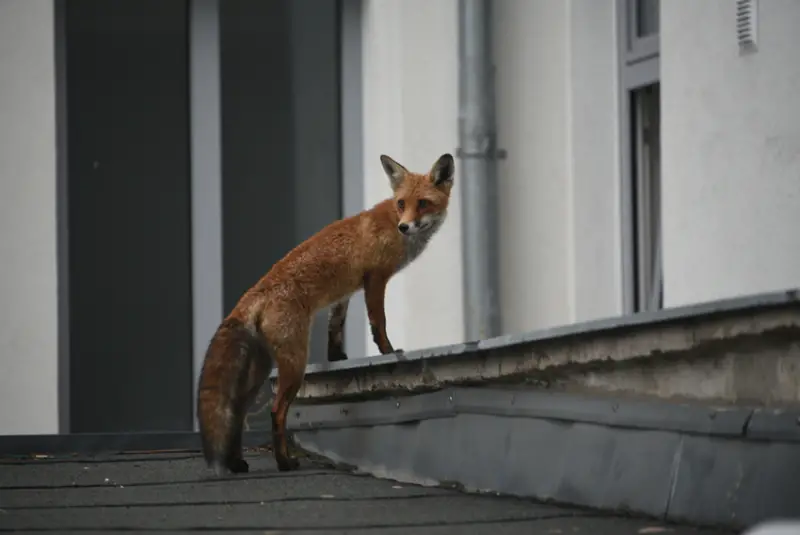
The Urban Fox is a city-dwelling version of the Red Fox (Vulpes vulpes), well-known for its adaptability and cleverness. It has a reddish-orange coat, bushy tail with a white tip, and a slender body. Urban foxes are typically bolder and more accustomed to human presence than their rural counterparts.
These foxes thrive in cities and suburbs across Europe, North America, and Australia. They make dens under sheds, in parks, or abandoned buildings, and scavenge for food from garbage bins, compost piles, and pet food left outside. They also hunt rodents and birds.
A fun fact about urban foxes is their ability to use pedestrian crossings, navigate traffic patterns, and even memorize garbage collection schedules. Their intelligence and adaptability have made them one of the most successful urban wildlife species.
Ursus maritimus

Ursus maritimus, the scientific name for the Polar Bear, is the largest land carnivore and a master of the Arctic environment. It has a thick layer of blubber, water-repellent fur, and large paws adapted for swimming and walking on ice. Despite its white appearance, its skin is black to absorb heat from the sun.
Polar bears are found throughout the circumpolar Arctic, especially along sea ice where they hunt seals, their primary prey. They are excellent swimmers and can travel long distances between ice floes in search of food. Their survival is tightly linked to the availability of sea ice.
A striking fact about Ursus maritimus is its ability to detect prey through thick ice. With an extraordinary sense of smell, a polar bear can locate a seal breathing hole from over a mile away and wait patiently for hours to ambush its meal—a testament to its persistence and precision as a predator.
Birds That Start With U
Umbrellabird (Cephalopterus spp.)
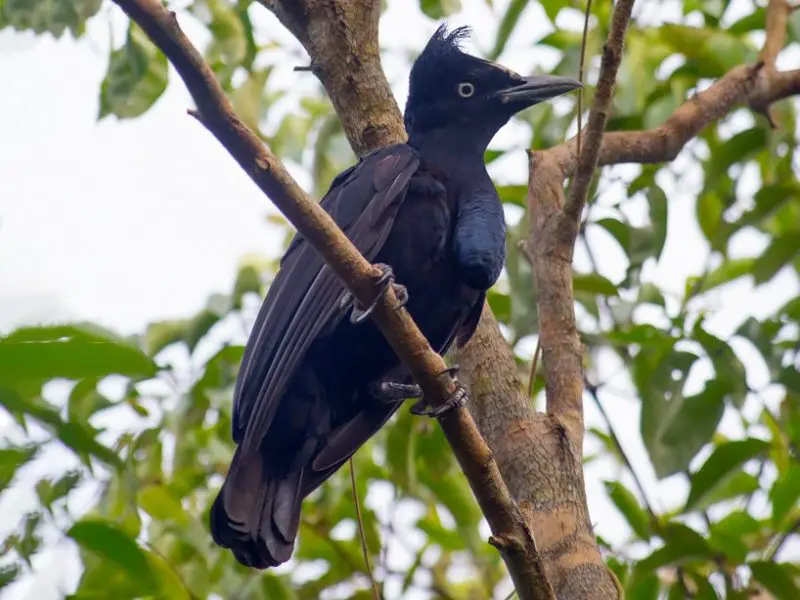
The Umbrellabird is an unusual and striking bird native to the tropical rainforests of Central and South America, especially along the Amazon Basin. It is named for the umbrella-like crest of feathers on its head, which males can raise dramatically during courtship displays. They are large, black birds with a prominent throat wattle that amplifies their deep, booming calls.
There are three species of Umbrellabird: the Amazonian, Long-wattled, and Bare-necked. These birds are primarily frugivorous, feeding on fruits and berries high in the forest canopy. They may also eat insects and small vertebrates. Umbrellabirds are solitary and prefer undisturbed forest habitats.
A fascinating fact about the Umbrellabird is the male’s ability to project its call over long distances. Their deep, resonating calls sound more like a distant drum than a bird. Due to habitat loss, some species, like the Long-wattled Umbrellabird, are considered vulnerable.
Ultramarine Flycatcher (Ficedula superciliaris)
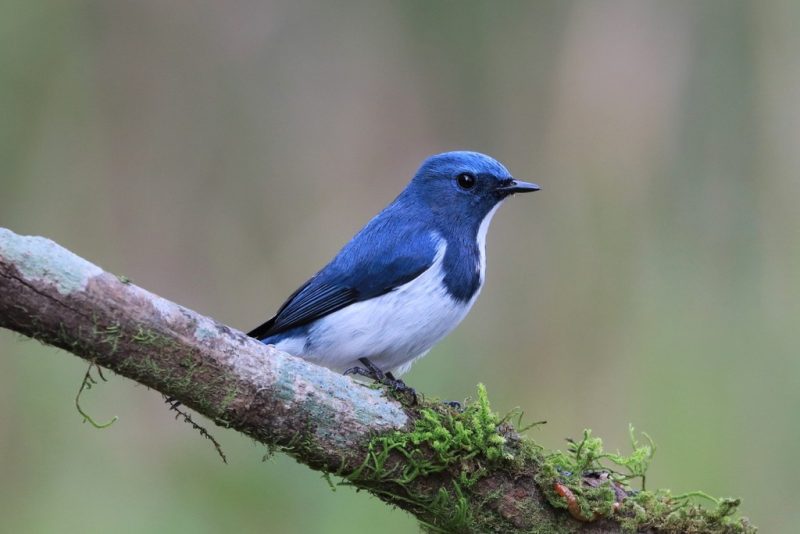
The Ultramarine Flycatcher is a small, vibrant songbird found in the Himalayan foothills and parts of northern India and Nepal. Males have a brilliant ultramarine blue back, white underparts, and a bold white eyebrow stripe, making them easy to distinguish from other small forest birds. Females are more subdued with olive-gray tones.
These birds prefer montane forests, especially broadleaf and mixed woodlands at elevations ranging from 1,500 to 3,000 meters. They feed mainly on insects, catching them mid-air in acrobatic displays or gleaning them from foliage. During winter, they migrate to lower elevations or the Indian plains.
A charming fact about the Ultramarine Flycatcher is its cheerful, whistled song, which brightens the forest canopy in spring. Despite its small size, this flycatcher is a key part of montane forest ecosystems, helping control insect populations.
Uniform Crake (Amaurolimnas concolor)
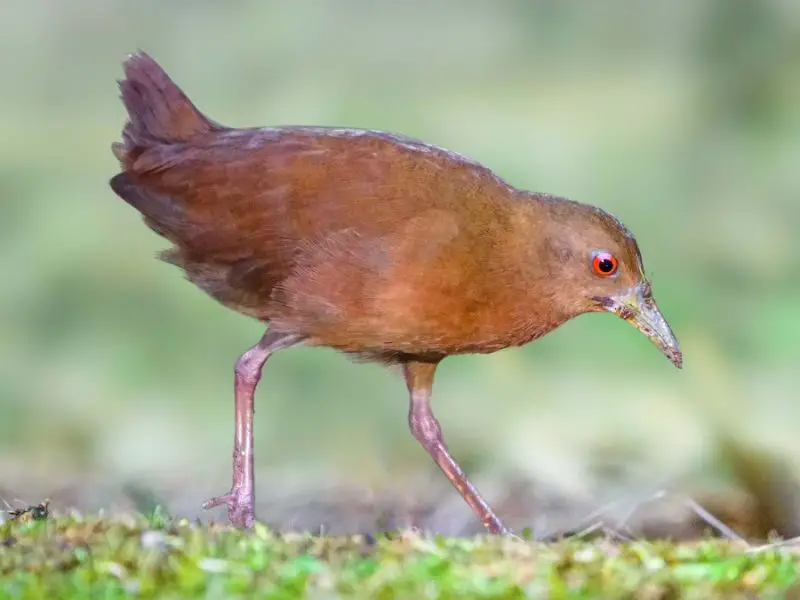
The Uniform Crake is a shy and elusive bird that inhabits dense tropical and subtropical forests, particularly in Central and South America. It gets its name from its plain, uniform brown or chestnut coloration, lacking the bold stripes or spots typical of many other crake species.
This secretive bird prefers humid, marshy undergrowth near streams and wetlands. It forages quietly on the ground for insects, small amphibians, and seeds. Because of its skulking behavior and preference for dense cover, it is more often heard than seen.
A unique fact about the Uniform Crake is that it communicates with a series of soft, repetitive whistles. These calls are sometimes the only clue to its presence. Due to its reclusive nature, very little is known about its breeding behavior or exact population numbers.
Upland Sandpiper (Bartramia longicauda)
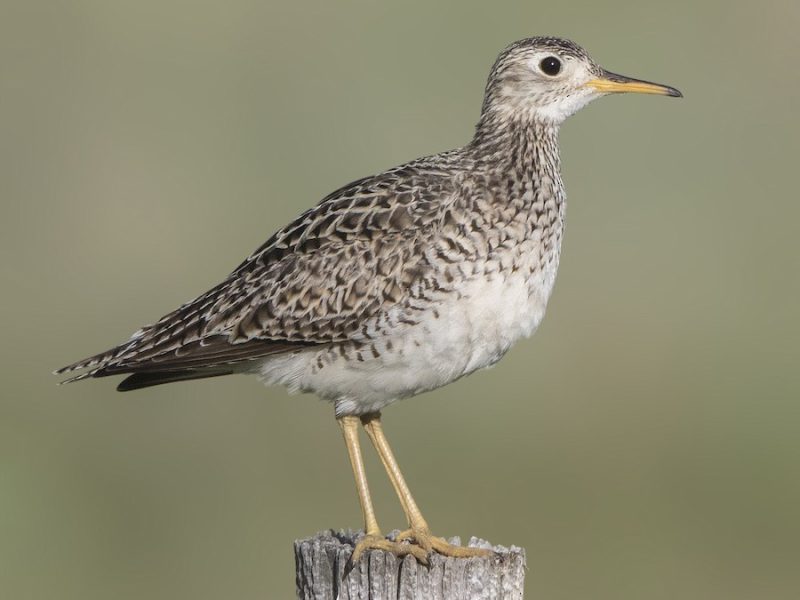
The Upland Sandpiper is a slender, long-legged shorebird with a small dove-like head and large dark eyes. Unlike many sandpipers, it prefers dry grasslands over wet coastal areas. Its plumage is mottled brown and white, providing excellent camouflage among tall prairie grasses.
This bird breeds across the central and northern Great Plains of North America and migrates to South America for the winter, especially to Argentina and Uruguay. It favors open habitats like pastures, hayfields, and native grasslands, where it feeds on insects, spiders, and other invertebrates.
A fun fact about the Upland Sandpiper is its distinctive, wolf-like whistle, often described as haunting or ethereal. It often perches on fence posts or even telephone poles, scanning the landscape, a behavior that makes it unique among its kin.
Upland Goose (Chloephaga picta)
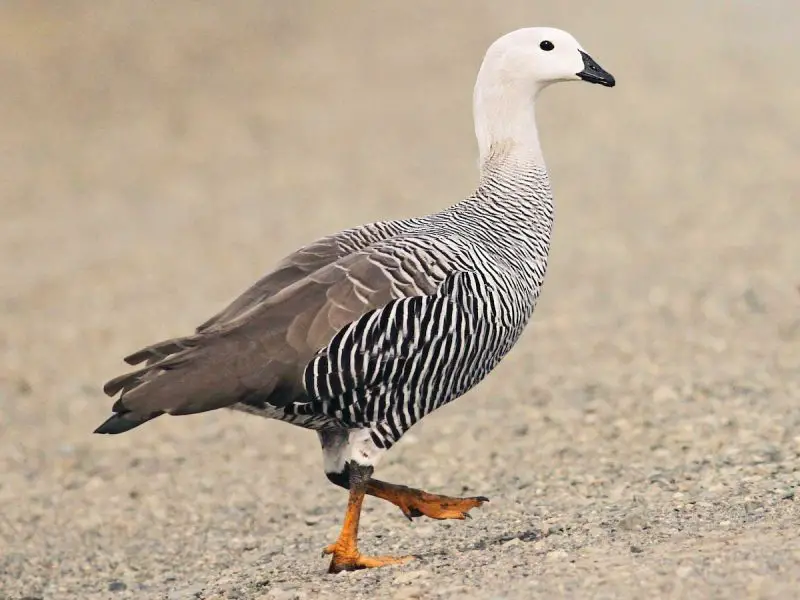
The Upland Goose is a striking and stout-bodied goose found in southern South America, particularly in Argentina, Chile, and the Falkland Islands. Males are mostly white with black barring on the wings, while females are rich cinnamon-brown with darker streaks. Both sexes have pink legs and short, strong bills.
These geese inhabit open grasslands, coastal meadows, and agricultural fields. They graze on grasses and herbs, often in pairs or small flocks. Though not migratory, some populations may move locally in response to seasonal conditions.
A notable fact about the Upland Goose is its role in the ecosystem as both grazer and prey. It is a preferred target of the Striated Caracara and other raptors in the Falklands. Males are especially protective of their mates and young, often standing guard while the female feeds.
Ural Owl (Strix uralensis)
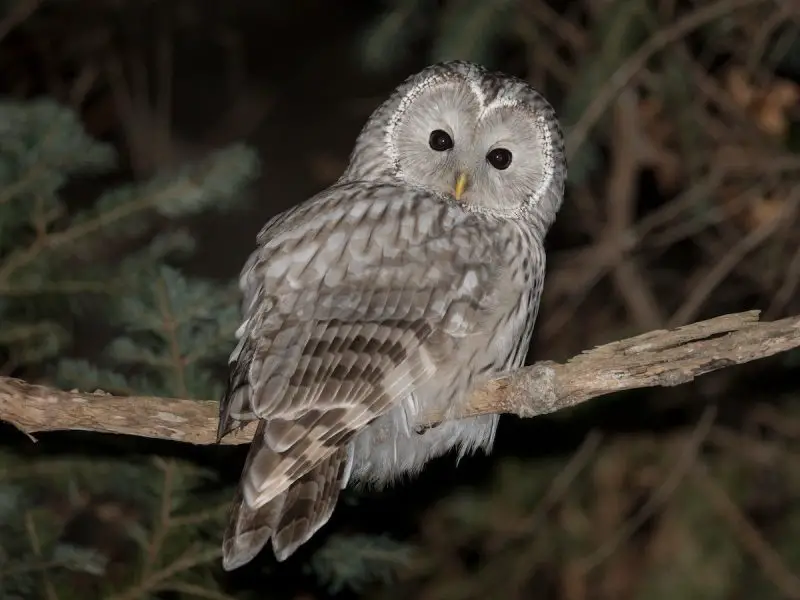
The Ural Owl is a large, pale-gray owl with a rounded head, dark eyes, and a yellow beak. Its plumage is finely streaked, giving it a soft, mottled appearance that helps it blend into the forest. It lacks ear tufts and has a long tail, which distinguishes it from other owl species in its range.
This species inhabits dense, old-growth forests across northern and eastern Europe, extending into Siberia and parts of Asia. It prefers mixed or coniferous forests with mature trees for nesting and open clearings for hunting. The Ural Owl feeds on small mammals, birds, and occasionally amphibians.
An interesting fact about the Ural Owl is its highly territorial nature. During breeding season, it will aggressively defend its nest, sometimes even attacking humans who get too close. Its haunting hoots echo through the forest, especially at night.
Unicolored Jay (Aphelocoma unicolor)

The Unicolored Jay is a medium-sized bird with sleek, deep blue plumage that is uniform across its body, giving it its name. It has a sturdy black bill, dark legs, and expressive dark eyes. Unlike some other jays, it lacks contrasting colors or a crest.
This jay is native to cloud forests and high-elevation woodlands in Central America, particularly in Guatemala, Honduras, and El Salvador. It is social and often found in small family groups foraging for insects, fruit, seeds, and small invertebrates in the forest canopy.
A notable fact about the Unicolored Jay is its cooperative breeding behavior. Young jays often stay with their parents and help raise subsequent broods. Their intelligence and social structure make them fascinating to observe in the wild.
Uluguru Bushshrike (Malaconotus alius)
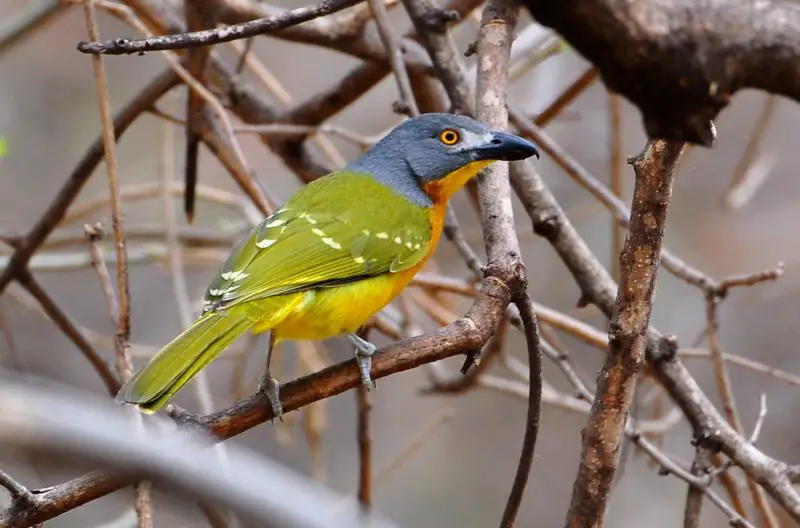
The Uluguru Bushshrike is a brightly colored, extremely rare bird endemic to the Uluguru Mountains in eastern Tanzania. It has a vivid yellow chest, greenish wings, and a contrasting black face mask and crown. Its secretive nature and dense forest habitat make sightings extremely rare.
This species inhabits montane forests between 1,200 and 2,300 meters in elevation. It prefers dense vegetation, where it hunts insects and other small invertebrates. Its population is very small and highly localized, confined to a few fragmented forest patches.
A remarkable fact is that the Uluguru Bushshrike was unknown to science until 1926 and then went unrecorded for nearly 50 years. Its rediscovery sparked major conservation interest due to its extreme rarity and limited range.
Udzungwa Forest Partridge (Xenoperdix udzungwensis)
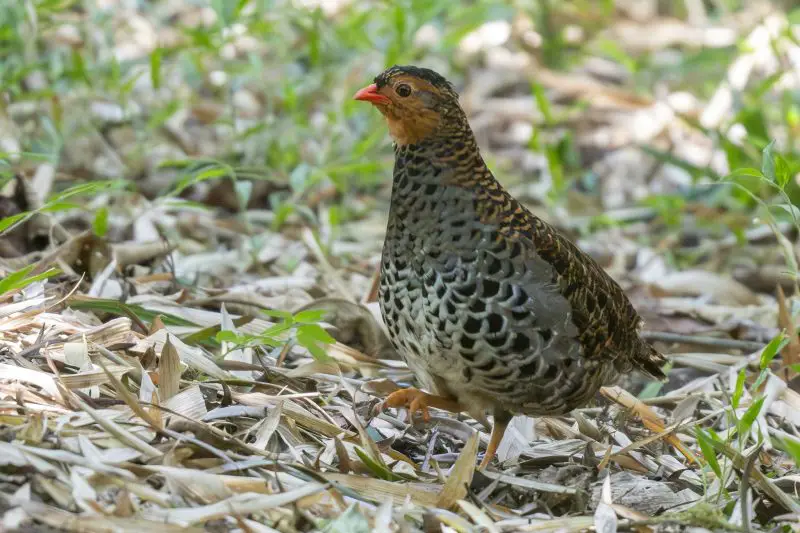
The Udzungwa Forest Partridge is a critically endangered bird found only in the Udzungwa Mountains of Tanzania. It is a small, ground-dwelling partridge with brown plumage, black-streaked markings, and a distinctive orange bill and legs. It was only discovered by scientists in 1991.
This bird inhabits montane rainforests between 1,300 and 2,000 meters in elevation. It feeds on insects, seeds, and fallen fruits, often scratching through the leaf litter on the forest floor. It is very shy and difficult to observe in the wild.
One fascinating fact about the Udzungwa Forest Partridge is that its closest relatives are thought to be species found in Asia, suggesting a long evolutionary history and biogeographical isolation. Its discovery was one of the most significant African ornithological finds of the late 20th century.
Uvea Parakeet (Eunymphicus uvaeensis)
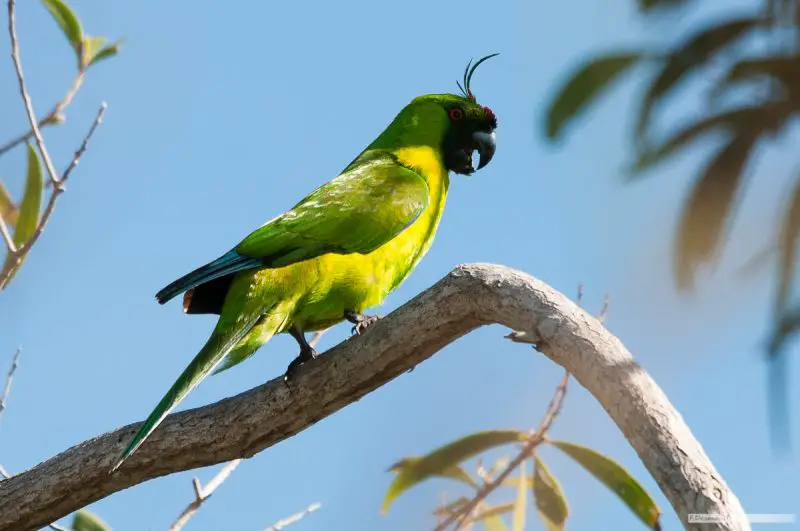
The Uvea Parakeet, also known as the Uvea or Yellow-green Parakeet, is a rare parrot species native to Uvea Island in the Wallis and Futuna archipelago of the South Pacific. It has a bright yellow-green body, a bluish crown, and black markings around the face and wings.
These parakeets inhabit native forest and secondary growth, especially areas with abundant fruiting trees. They nest in tree cavities and feed on a variety of seeds, berries, and nectar. Habitat loss and introduced predators have severely impacted their numbers.
A unique fact about the Uvea Parakeet is that it is one of the few parrot species endemic to a single tiny island. Conservation programs have been implemented to protect their remaining habitat and control invasive species such as rats and cats.
Reptiles & Amphibians That Start With U
Uromastyx (Uromastyx spp.)
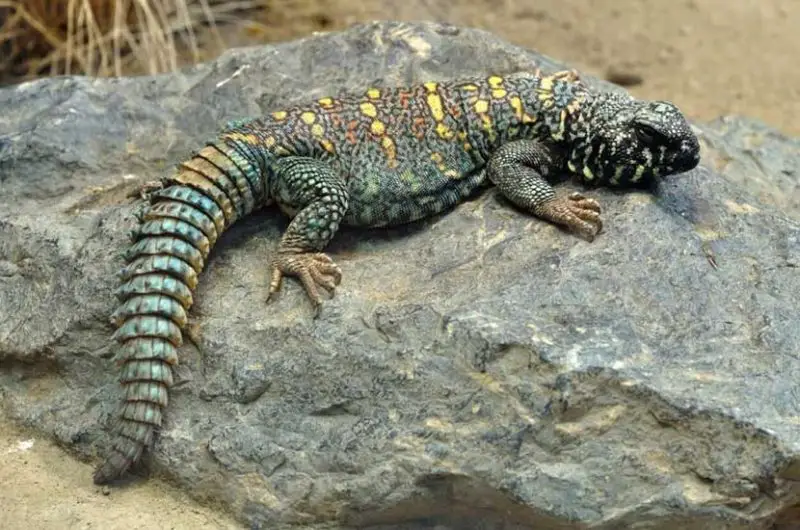
Uromastyx, also known as spiny-tailed lizards, are robust, herbivorous reptiles found in arid regions across North Africa, the Middle East, and parts of Central Asia. They have muscular bodies, strong limbs, and a thick, spiky tail that serves as a defense mechanism against predators. Their coloration can vary from sandy brown to vibrant yellows or greens, depending on the species and habitat.
These lizards inhabit rocky deserts and scrublands, where they shelter in burrows to escape the intense heat. Uromastyx species are diurnal and rely heavily on basking to regulate their body temperature. Their diet consists mostly of leafy greens, flowers, and seeds, making them unique among reptiles for their almost exclusive plant-based diet.
A fun fact about Uromastyx is that they can tolerate extremely high body temperatures — up to 115°F (46°C) — making them some of the most heat-adapted lizards on Earth. Their tail, covered in sharp scales, can be whipped like a club in defense.
Uta Lizard (Uta stansburiana)
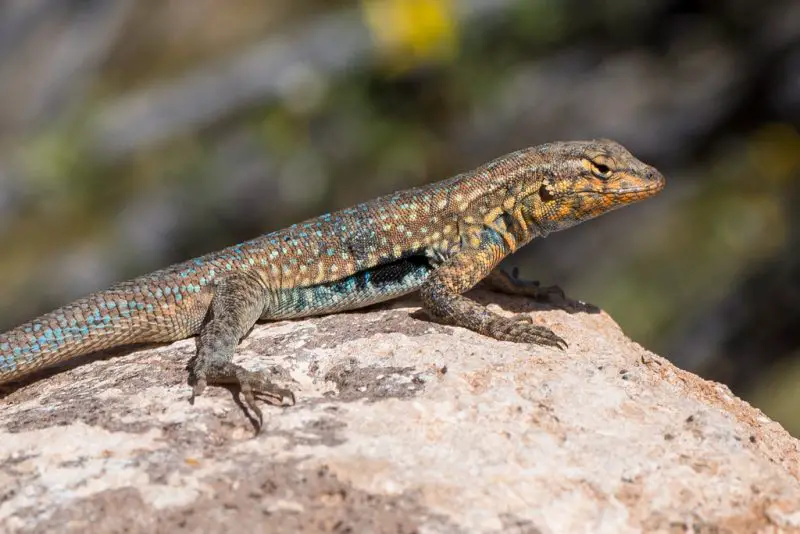
The Uta Lizard, or common side-blotched lizard, is a small, agile reptile native to the deserts and grasslands of western North America. It is easily recognized by the dark blotch located just behind each of its front limbs. Its coloration ranges from sandy brown to gray with subtle markings that provide camouflage in its arid environment.
These lizards are highly adaptable and can be found in a wide variety of habitats including rocky outcrops, desert scrub, and even suburban areas. They are insectivorous, feeding on ants, beetles, spiders, and other small invertebrates. Males are known for their throat color variations, which reflect different mating strategies — a rare example of a genetic “rock-paper-scissors” system.
A fascinating fact about Uta lizards is that despite their small size, they have been the subject of extensive evolutionary research, particularly for their dynamic mating behaviors and color morphs, which can shift in frequency over generations.
Upland Chorus Frog (Pseudacris feriarum)

The Upland Chorus Frog is a small, secretive amphibian found throughout the southeastern United States, particularly in grassy fields, woodland edges, and wetlands. It is typically tan, gray, or brown with three dark stripes running down its back and a distinctive dark line through the eye.
During the breeding season in late winter and early spring, males congregate in shallow water and produce a loud, rising “crreeeek” call that resembles the sound of running a finger along a comb. Outside of the breeding season, they are hard to spot as they remain hidden under leaf litter or vegetation.
A fun fact is that despite their tiny size — usually less than 1.5 inches long — Upland Chorus Frogs can project their mating calls across surprisingly long distances. Their early breeding period often makes them one of the first frogs heard in late winter.
Uluguru Forest Tree Frog (Leptopelis uluguruensis)
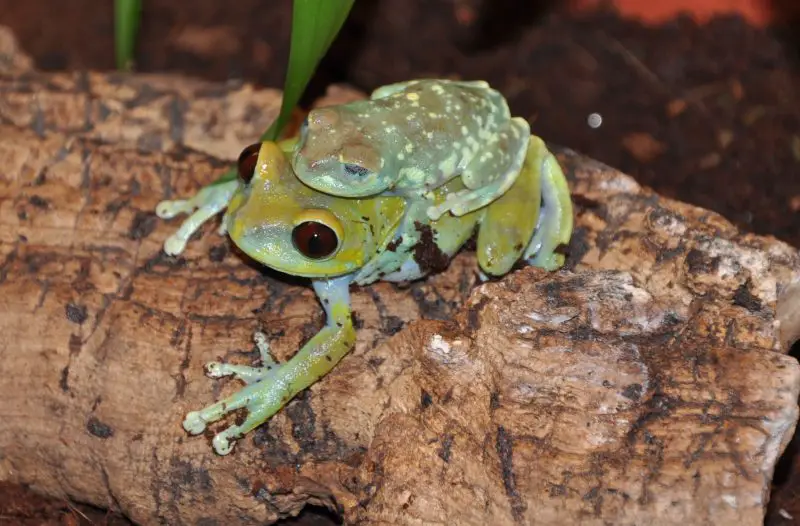
The Uluguru Forest Tree Frog is a rare and colorful amphibian species endemic to the Uluguru Mountains of eastern Tanzania. It has a striking appearance, often displaying green or brownish-green hues with subtle patterning that blends into the forest environment. Its large toe pads aid in gripping leaves and branches.
This frog inhabits moist, montane forests at elevations between 1,400 and 2,400 meters. It relies on clean, slow-moving water for breeding and is highly sensitive to habitat disturbance. As a nocturnal species, it spends most of the day hidden in foliage and becomes active at night to forage for insects and other small invertebrates.
A unique fact is that the Uluguru Forest Tree Frog is considered an indicator species for the health of its ecosystem. Because of its limited range and sensitivity to environmental change, its presence is a sign of a relatively undisturbed forest.
Uroplatus (Leaf-tailed Gecko)
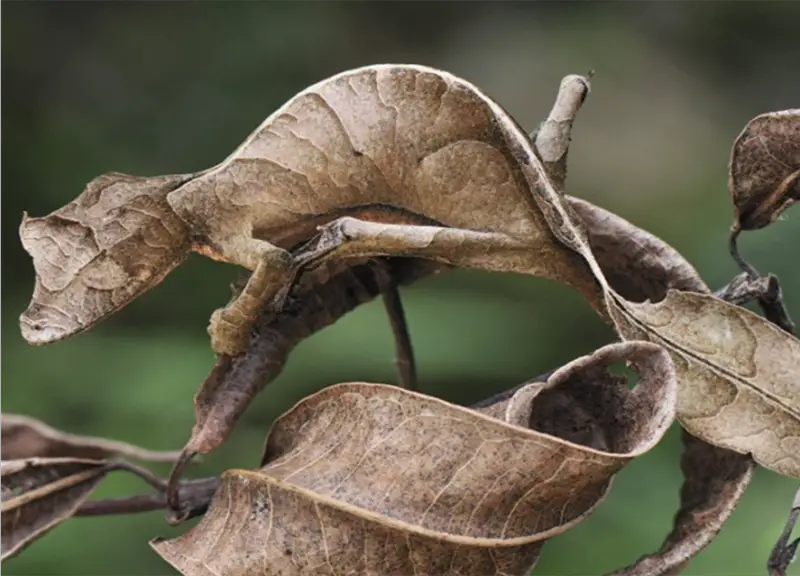
Uroplatus is a genus of geckos endemic to Madagascar, commonly known as leaf-tailed geckos due to their remarkable camouflage. These geckos have flat, broad bodies and tails that closely resemble dead leaves — complete with notched edges and leaf-like veins. Their cryptic coloration makes them masters of disguise.
They inhabit tropical rainforests, where they cling to tree trunks and branches during the day, blending seamlessly with bark and foliage. At night, they become active and hunt insects. Their large, lidless eyes offer excellent night vision, and their specialized toe pads allow them to cling to almost any surface.
One amazing fact about Uroplatus geckos is their ability to press their bodies completely flat against a surface, eliminating shadows and making them nearly invisible even at close range. Some species even have skin flaps along their sides that help them further blend in with the forest environment.
Fish That Start With U
Unicorn Fish (Naso spp.)
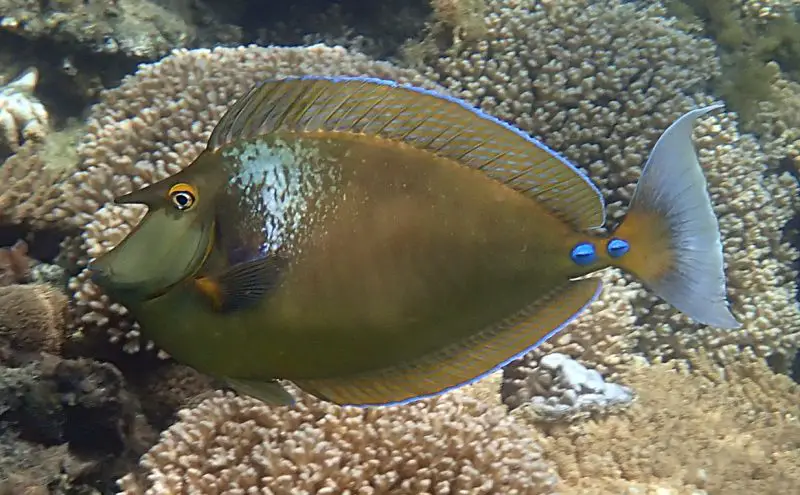
Unicorn Fish are a group of marine fish named for the horn-like projection on their foreheads, most prominent in adult males of certain species. These tropical fish belong to the surgeonfish family and typically have elongated bodies, small scales, and bright coloration, often with shades of blue, silver, or yellow.
They are commonly found in coral reefs and lagoons throughout the Indo-Pacific region, including areas from Hawaii to East Africa. Unicorn Fish are herbivorous and graze on algae, which helps maintain the health of coral reef ecosystems. They prefer warm, shallow waters and are often seen swimming in small schools.
A fascinating fact is that the “horn” on a Unicorn Fish’s head has no known function, but it may play a role in dominance or mating displays. Despite their size and appearance, they are peaceful fish and are sometimes kept in large marine aquariums.
Upside-Down Catfish (Synodontis spp.)
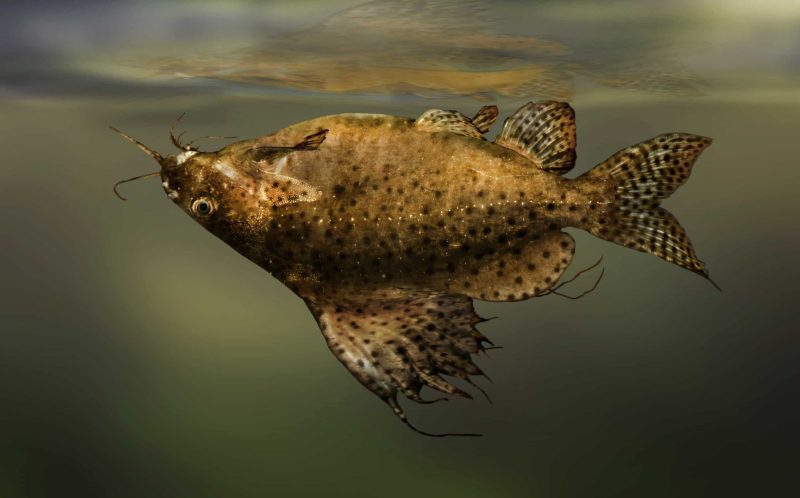
Upside-Down Catfish are a unique group of freshwater catfish that frequently swim upside-down, a behavior that helps them feed more efficiently on the undersides of submerged logs and leaves. They have flattened bellies, mottled coloration, and strong pectoral fins, making them easily identifiable.
Native to Africa, especially in the Congo River Basin and other slow-moving waters, these catfish thrive in murky environments with plenty of hiding places. They are omnivorous, feeding on insects, crustaceans, and detritus. In captivity, they are popular in aquariums for their quirky behavior and ease of care.
One fun fact is that their inverted swimming posture is not constant — they switch orientation depending on their activity. Their upside-down movement is aided by adaptations in their swim bladder and body shape, allowing for excellent balance in both positions.
Uaru Cichlid (Uaru amphiacanthoides)
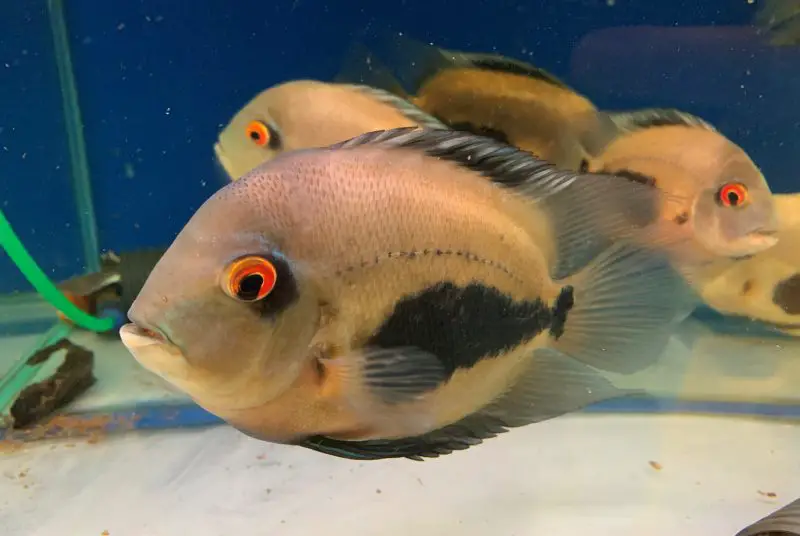
The Uaru Cichlid is a peaceful, intelligent freshwater fish from the Amazon Basin, often referred to as the “triangle cichlid” due to its distinctive body shape. It displays a rounded, disc-like form with earthy tones and a dark vertical blotch near the center of the body.
This species inhabits calm, slow-moving rivers and floodplain lakes where it feeds on plant matter, algae, and occasionally small invertebrates. Uaru Cichlids are social and form tight bonds, often seen swimming in pairs or groups. They are popular in aquariums because of their gentle temperament and striking behavior.
A notable fact is that Uaru Cichlids are known to recognize their keepers and can even be trained to take food from human hands. During breeding, they exhibit strong parental care, with both parents guarding and cleaning the eggs and fry.
Ulrey’s Tetra (Hemigrammus ulreyi)
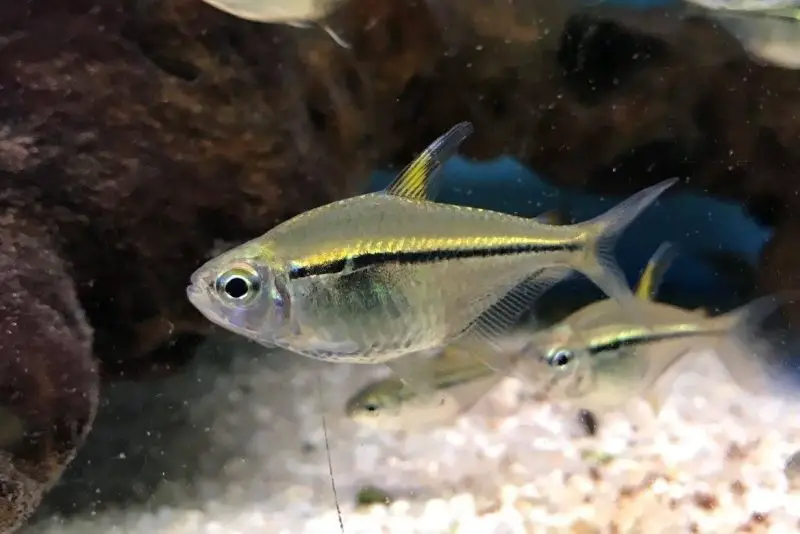
Ulrey’s Tetra is a small, peaceful freshwater fish native to South America, particularly found in the Paraguay and Paraná river systems. It features a translucent silver body marked by a dark horizontal stripe and hints of yellow on its fins, making it a subtle but attractive aquarium species.
These tetras prefer calm, clear waters with dense aquatic vegetation. In the wild, they swim in schools for safety and feed on tiny insects, crustaceans, and plant debris. In captivity, they thrive in planted tanks with soft, slightly acidic water and low lighting.
An interesting fact about Ulrey’s Tetra is its shimmering appearance under light, which helps it blend into dappled water environments and evade predators. Its calm demeanor and social nature make it ideal for community aquariums.
Umatilla Dace (Rhinichthys umatilla)

The Umatilla Dace is a small, elusive freshwater fish found in the Pacific Northwest of the United States and parts of Canada. It has a slender body with a speckled pattern of black and brown and is typically less than 4 inches long. Its mouth is adapted for feeding along the bottom of streams.
This species inhabits cool, fast-flowing streams and rivers with gravelly or rocky bottoms. It prefers well-oxygenated water and often hides under rocks or in riffles. The Umatilla Dace feeds primarily on aquatic insects and small invertebrates.
A unique fact is that the Umatilla Dace is considered an indicator species for stream health. Because of its sensitivity to pollution and habitat disruption, its presence in a waterway often signals good ecological conditions.
Invertebrates That Start With U
Urchin (Sea Urchin)
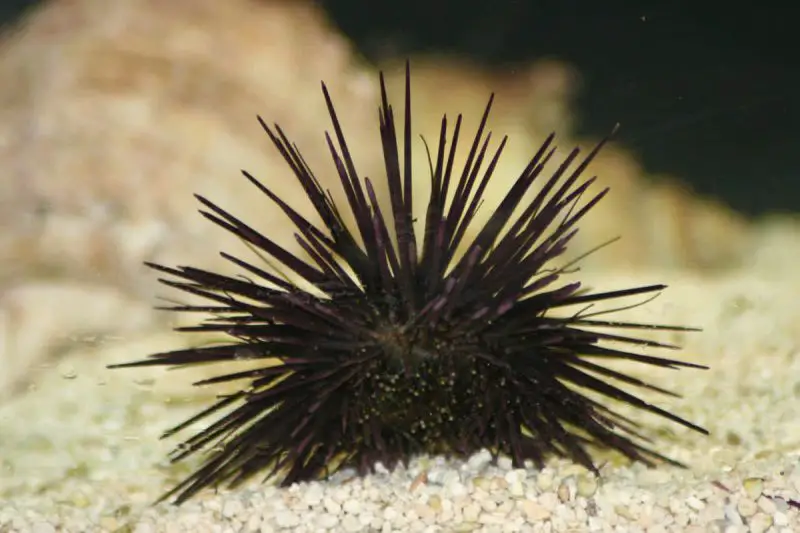
Sea Urchins are spiny, globular marine animals belonging to the class Echinoidea. They have hard, round shells called tests, covered in movable spines used for protection and movement. Depending on the species, their color can range from black and purple to red, green, or even white, and they often have tube feet extending from their undersides for locomotion and feeding.
These creatures live on the seabed, particularly in shallow coastal waters with rocky substrates or coral reefs. They are found in oceans all over the world, from the intertidal zone to depths of several thousand meters. Sea urchins are grazers that primarily feed on algae, playing a crucial role in maintaining the balance of marine ecosystems.
A fun fact is that sea urchins have a unique feeding structure called “Aristotle’s lantern,” a set of five calcium carbonate teeth that allows them to scrape algae from rocks. Despite their spiny appearance, many species are edible and are considered a delicacy in various cuisines, especially in Japan.
Unicorn Caterpillar Moth (Schizura unicornis)

The Unicorn Caterpillar Moth is a North American moth known for its striking larval form, which features a prominent horn-like projection on its back, giving it the “unicorn” name. As an adult moth, it has a wingspan of about 3–4 cm with mottled gray-brown forewings that help it blend into tree bark.
Its caterpillars are typically green with purple or reddish markings and feed on the leaves of various hardwood trees, including birch, oak, and cherry. These larvae are usually found in forests and wooded suburban areas in eastern and central parts of the United States and Canada.
A fascinating fact is that when disturbed, the caterpillar arches its body and flails, using its horn and bright colors to startle predators. Although the horn looks intimidating, it is harmless and serves only as a defense mechanism through mimicry.
Underwing Moth (Catocala spp.)
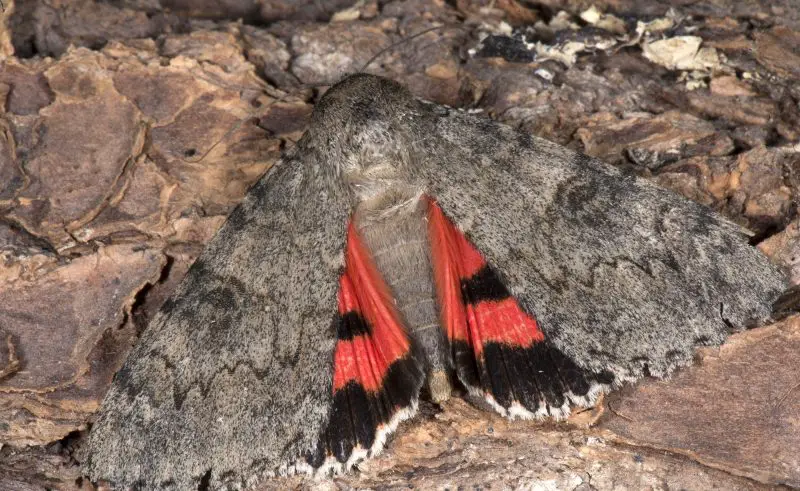
Underwing Moths are a diverse group of nocturnal moths known for their cryptic forewings and vividly colored hindwings, often hidden while at rest. The forewings are usually gray or brown and patterned like tree bark, while the hindwings can be bright orange, red, pink, or yellow, often with dark bands.
These moths are widely distributed across North America, Europe, and parts of Asia, typically inhabiting deciduous forests and woodland edges. Their larvae feed on the leaves of various trees, including oak, poplar, and willow, while the adults are active at night and are attracted to light and fermented fruit.
One interesting fact is that when startled, the Underwing Moth suddenly reveals its colorful hindwings, which can confuse or scare off predators like birds. This startle display is a classic example of deimatic behavior in insects.
Ulysses Butterfly (Papilio ulysses)
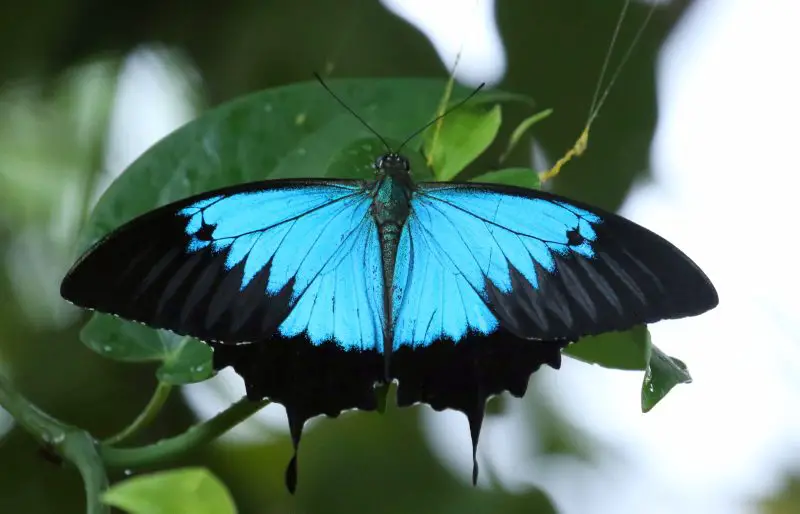
The Ulysses Butterfly, also known as the Blue Mountain Swallowtail, is one of the most iconic butterflies of Australia and Papua New Guinea. It is easily recognized by its brilliant electric-blue upper wings, edged in black, which contrast with its dark brown or black underwings.
This butterfly thrives in tropical rainforests, especially in northeastern Queensland, where it flits through the forest canopy and gardens. It feeds on the nectar of various flowering plants, particularly those in the citrus family, and plays a role in pollination.
A fun fact is that the Ulysses Butterfly is a symbol of tourism in Queensland and often appears on signs and souvenirs. Despite its dazzling appearance, its rapid, erratic flight makes it surprisingly difficult to photograph in the wild.
Umbrella Octopus (Opisthoteuthis spp.)
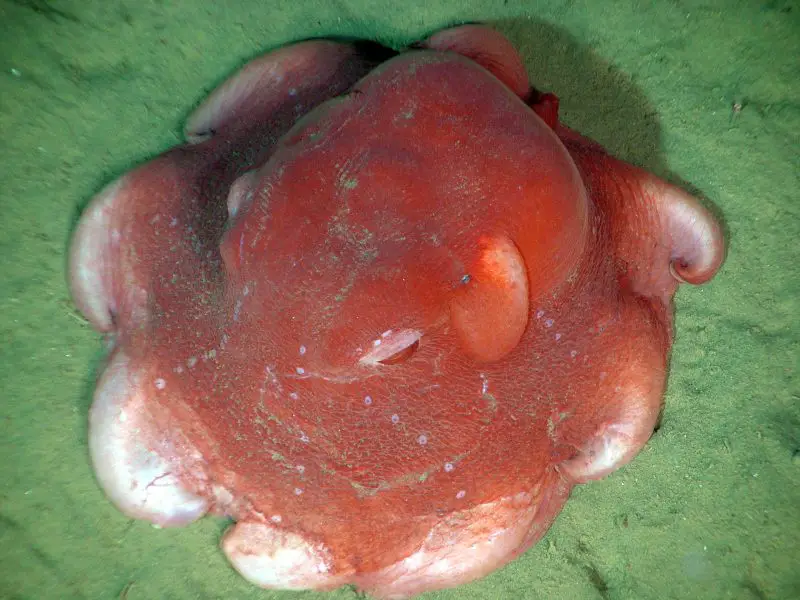
The Umbrella Octopus is a deep-sea cephalopod named for the webbing that connects its arms, which spreads like an umbrella when it swims or defends itself. These octopuses have soft, gelatinous bodies and are typically small, with some species like Opisthoteuthis californiana measuring just a few inches long. They usually appear in reddish or purplish hues and are adapted to life in the deep ocean.
This elusive creature inhabits the deep waters of oceans around the world, including the Atlantic, Pacific, and Indian Oceans. They are found at depths often exceeding 1,000 meters, where sunlight does not penetrate. Due to the pressure and darkness, they have developed specialized adaptations such as neutral buoyancy and a slow, energy-efficient lifestyle.
A fascinating fact is that the Umbrella Octopus has a unique defense mechanism: when threatened, it can puff up its body and stretch out its webbed arms, forming a defensive “umbrella” shape to confuse predators. Some species also exhibit bioluminescence, which may help deter threats or attract mates in the deep sea.
Uropod Mite
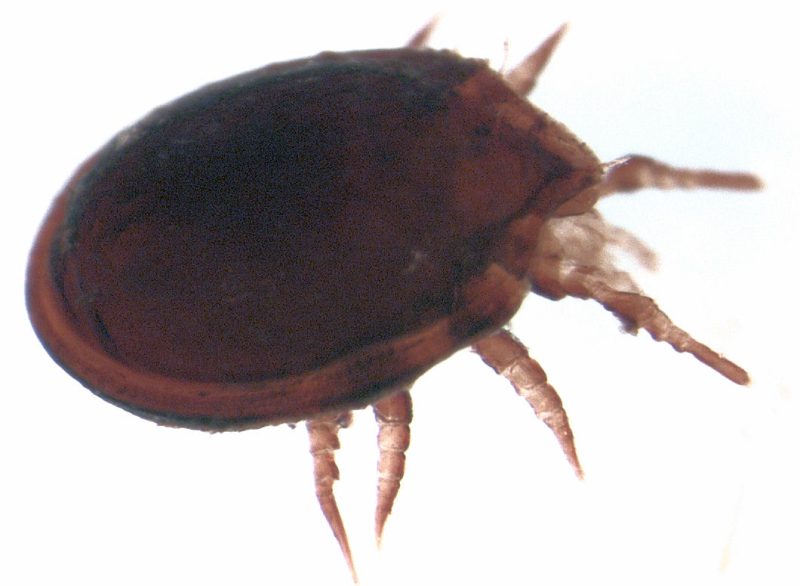
Uropod Mites are tiny arthropods belonging to the order Mesostigmata and are known for their shield-shaped bodies and a pair of posterior appendages called uropods. They often have a hard exoskeleton and range in color from reddish-brown to black. Their size typically measures less than 2 millimeters, making them almost invisible to the naked eye.
These mites can be found in a wide variety of habitats, including soil, leaf litter, decaying wood, and animal nests. Some species are free-living detritivores, feeding on organic matter, fungi, or microorganisms, while others are commensal or mildly parasitic, often hitching rides on insects or living in symbiosis with ants or beetles.
An interesting fact about Uropod Mites is their ability to attach themselves to larger arthropods through a behavior called phoresy. This allows them to be transported to new habitats, especially useful for species with limited mobility or those living in patchy environments.
Undulate Ray (Raja undulata)
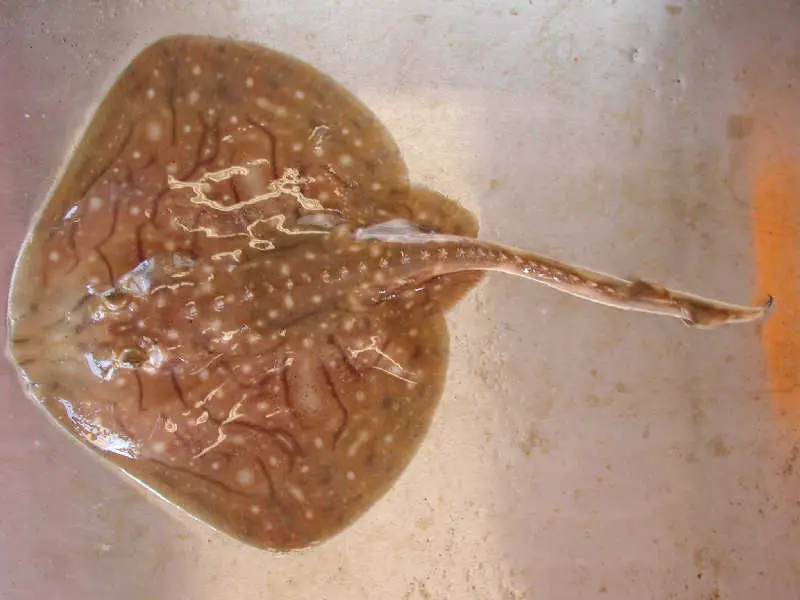
The Undulate Ray is a beautifully patterned species of skate, recognized by its rounded pectoral fins and the undulating, wavy patterns that adorn its dorsal surface. Its body is flattened and disk-shaped, and it typically exhibits a coloration of light brown with darker brown or black spots and lines that help it blend into the seafloor.
Native to the northeastern Atlantic Ocean and parts of the Mediterranean Sea, this ray prefers sandy or muddy bottoms in coastal and shelf areas, usually at depths of 20 to 200 meters. It feeds on bottom-dwelling invertebrates like crustaceans, mollusks, and small fish. Despite its flattened body, it swims gracefully by rippling its fins.
A notable fact is that the Undulate Ray is listed as endangered in several regions due to overfishing and habitat degradation. It is slow to mature and produces relatively few eggs, which makes its population especially vulnerable to decline. Conservation efforts are in place in parts of Europe to protect this species from further depletion.
Read More:


